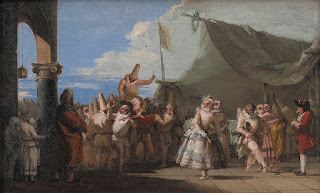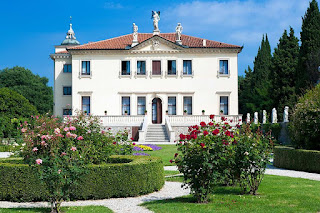NEW - Giovanni Domenico Tiepolo – painter and printmaker
Famous artist’s son developed his own style
Giovanni Domenico Tiepolo, who became famous for his paintings of Venetian life and of the clown, Pulcinella, was born on this day in 1727 in Venice. Also known as Giandomenico Tiepolo, he was one of the nine children born to the artist Giovanni Battista Tiepolo and his wife, Maria Guardi, the sister of painters Francesco and Giovanni Guardi. Perhaps not surprisingly, Giandomenico inherited the talent to go into the same profession as his father and uncles and, by the age of 13, he had become the elder Tiepolo’s chief assistant. His younger brother, Lorenzo, also became a painter and worked as an assistant to his father. By the age of 20, Giandomenico was already producing his own work for commissions. However, he continued to accompany his father when he received his major commissions in Italy, Germany and Spain. He assisted his father with a grand stairwell fresco for a prince’s palace in Wurzburg in Bavaria in 1750 and with decorations for the Villa Valmarana ai Nani in Vicenza in 1757 and the Royal Palace of Madrid in 1770. The elder Tiepolo died while in Madrid and after Giandomenico returned to live in Venice. Read more…
______________________________________
Joe Petrosino - New York crime fighter
Campanian immigrant a key figure in war against Mafia
Joe Petrosino, a New York police officer who dedicated his life to fighting organised crime, was born Giuseppe Petrosino in Padula, a southern Italian town on the border of Campania and Basilicata, on this day in 1860. The son of a tailor, Prospero Petrosino, he emigrated to the United States at the age of 12. The family lived in subsidised accommodation in Mulberry Street, part of the area now known as Little Italy on the Lower East Side towards Brooklyn Bridge, where around half a million Italian immigrants lived in the second half of the 19th century. Giuseppe took any job he could to help the family, at first as a newspaper boy and then shining shoes outside the police headquarters on Mulberry Street, where he would dream of becoming a police officer himself. In 1878, by then fluent in English and known to everyone as Joe, Petrosino became an American citizen but it took him five years and repeated applications to realise his dream of joining the police. At 5ft 3ins he was technically too short to meet the criteria for an officer but after the police began to use him as an informant it was decided he could be of use in the fight against Italian organised crime. Read more…
__________________________________________
Andrea Gabrieli - composer
Father of the Venetian School
The Venetian composer and organist Andrea Gabrieli, sometimes known as Andrea di Cannaregio, notable for his madrigals and large-scale choral works written for public ceremonies, died on this day in 1585. His nephew, Giovanni Gabrieli, is more widely remembered yet Andrea, who was organist of the Basilica di San Marco – St Mark’s – for the last 19 years of his life, was a significant figure in his lifetime, the first member of the Venetian School of composers to achieve international renown. He was influential in spreading the Venetian style of music in Germany as well as in Italy. Little is known about Andrea’s early life aside from the probability that he was born in the parish of San Geremia in Cannaregio and that he may have been a pupil of the Franco-Flemish composer Adrian Willaert, who was maestro di cappella at St Mark’s from 1527 until 1562. In 1562 – the year of Willaert’s death – Andrea is on record as having travelled to Munich in Germany, where he met and became friends with Orlando di Lasso, who wrote secular songs in French, Italian, and German, as well as Latin. There was evidence in the later work of Di Lasso of a Venetian influence. Read more…
______________________________________
Emanuele Filiberto – Duke of Savoy
Ruler who made Turin the capital of Savoy
Emanuele Filiberto of Savoy, who was nicknamed testa di ferro (iron head) because of his military prowess, died on this day in 1580 in Turin. After becoming Duke of Savoy he recovered most of the lands his father Charles III had lost to France and Spain and he restored economic stability to Savoy. Emanuele Filiberto was born in 1528 in Chambery, now part of France. He grew up to become a skilled soldier and served in the army of the emperor Charles V, who was the brother-in-law of his mother, Beatrice of Portugal, during his war against Francis I of France. He distinguished himself by capturing Hesdin in northern France in July 1553. When he succeeded his father a month later he began the reacquisition of his lands. His brilliant victory over the French at Saint Quentin in northern France in 1557 on the side of the Spanish helped to consolidate his power in Savoy. The peace of Cateau-Cambresis in 1559 ended the wars between Charles V and the French Kings and restored part of the Duchy of Savoy back to Emanuele Filiberto on the understanding that he would marry Margaret of France, the sister of King Henry II. Read more…
_-_VIA_CRUCIS_II_-_Jesus_carries_his_cross_by_Giandomenico_Tiepolo%20(1).jpg)
.jpg)

.jpg)

_-_VIA_CRUCIS_II_-_Jesus_carries_his_cross_by_Giandomenico_Tiepolo.jpg)



.jpg)
.jpg)
.jpg)
.jpg)
%20(1).jpg)
